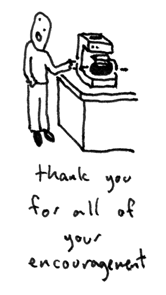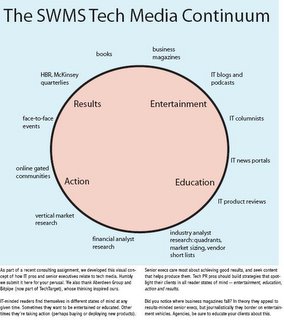
If you’re a PR pro who believes in PR’s merits, do a Google search on the phrase, “
PR is dead.” Does it make ya mad?
A fair number of reputable bloggers have pounced on this meme. People ranging from journalist
Tom Foremski to bizblogger
Dave Taylor to Sun Microsystems exec
Tim Bray have deduced that blogging (and related "new media") will surely de-value or even kill off the PR industry.
The problem is that the blogging bandwagon – which admittedly looks more like a
Lamborghini than a horse-drawn carriage – is speeding along a twisty mountain road. Fun, fast, exciting. But, “visibility is limited.”
I can’t be the only one who doubts that an overwhelming number of corporate employees are panting to tell us all of their behind-the-scenes truths, regardless of whether they are helping or hurting their employers' cause.
(Aren’t they working hard enough as it is?)I can’t be the only one who scratches their head at the prospect of journalists spending their time scouring these insiders’ official & unofficial blogs, and/or taking user comments on their own journo-blogs as gospel story leads.
(Reporters get frustrated as it is, when approached by PR people with legitimate stories; at least we are professionals!) I
know I am
not the only one to think that PR skills are not strictly confined to, or impacted by, the “state of traditional media.”
More sagacious folk like “info provocateur”
Amy Gahran do make good points about the media being ever-more search and aggregation-centric, which begs the question why we still bother using the wire services when a
del.icio.us-tagged fact-sheet might well do the trick. This trend
could imply a disintermediation of PR agencies … But then again, we ain’t
just about press releases, and, it’s not as if corporations haven’t been able to hire in-house comms crews all this time.
(If anyone ought to be scared, surely it’s the newswires. Are you listening, Mr. Buffet?)Dave Taylor argues that "the message"
can't be controlled; that "command and control"-style PR is going to fade away. This is not scary; this is our
opportunity.
As I’ve noted
again and
again (and
again!): our field is
wide open. Our skill sets will
always be in demand.
Even if the press release becomes a mere mote in the news media
tag cloud, someone's going to have to craft the message (or help the client to coax an advantage out of an out-of-control
ideavirus); someone's going to need to think about & plan for how the message will be received by various publics; and someone must ensure that the message is re-crafted and leveraged as it evolves online. We can do that. We
do do that, now.
And meanwhile our “traditional” role with the “traditional” media will take years to truly and completely fade-out - even as forward-thinkers in our field are already embracing RSS, Technorati, del.icio.us,
et al., with uncommon vigor.
Here’s an analogy I dreamt up while cleaning my garage this weekend…Remember when the “For Sale By Owner” (FSBO) trend hit its peak in the real estate market, circa 1997? At the time, 'Net pundits breathlessly predicted that the Internet would completely disenfranchise the Realtor community.
In fact, by year-end 1997, fully 18 percent of homes were sold without the assistance of a Realtor – an all-time high! The hand-writing was on the wall for those greedy, clueless Realtors!
Fast forward to 2006: a
real estate industry survey recently found the FSBO trend to have reached an all-time low.
What happened? Wasn’t the Internet supposed to change everything?The Internet
did change everything. It made it easy to find and to efficiently compare most all relevant realty data points. The Internet added transparency to the entire process. Public records, photos, virtual walk-throughs,
etc., all went online. The home buying community was empowered.
The home
sellers were the ones who were disenfranchised. They were the greedy, clueless ones. More than ever before, they needed to MARKET their homes (warts and all). Services like
ForSaleByOwner.com sprang up to help, but never gained enough traction to tip the scales forevermore in favor of the FSBO movement.
With the interests of the buyers and sellers so at-odds,
each party decided for their own reasons to
return to the knowledgeable Realtors, who could act as an unbiased 3rd party MEDIATOR (for the buyers) and tech-savvy MARKETER (for the sellers).
Am I suggesting that PR people are the Realtors of the blogging era?No. The press is the mediator. The corporation is the marketer. Audiences and stakeholders represent "buyers." PR people – to extend the real estate analogy – are the STAGERS.
If you’ve ever shopped for a home, you’ve seen the difference between a house that’s been “tidied-up” and one that’s been “staged” with crisp linens, potted flowers, rustic furniture pieces and exotic knick-knacks. Here’s an official-sounding
description of home staging that (conveniently) suits my analogy to PR:
Staging is the art of styling a property to increase its market value and give it a competitive edge in today's real estate market. Staging combines business know-how with a designer's eye to style homes so that they show well, and subsequently sell well … Professional property staging is an effective real estate marketing tool that will help a home put its best face forward and stand out amongst the crowd. Staging is not an emotional process; it is a business decision for homeowners and real estate agents who want to present their properties in the best possible light, to facilitate faster sales at higher prices.
 (Here are some before & after photos of property staging. See the difference?)
(Here are some before & after photos of property staging. See the difference?)

Now, re-write this paragraph to suit the analogy:
PR is the art of styling a company’s message to increase its market value and give it a competitive edge in today's market. PR combines business know-how with an expert's eye to craft messages so that they show well across multiple audience segments, and subsequently sell well … Professional PR is an effective marketing tool that will help a company put its best face forward and stand out amongst the crowd. PR is not an emotional process; it is a business decision for companies who want to present their products in the best possible light, to facilitate faster sales at higher prices.
PR is not dead. What deserves to die is the “PR Is Dead” meme so popular these days. Ask any skilled property stager if they can turn a cesspit into a palace, they’ll say “yes!” Ask any skilled PR pro if they can spin a compelling narrative across
any number of inter-connected channels and audiences, and they’ll say, “HELL, YES!”
PR is dead? Bull.
 Tom Foremski over at SiliconValleyWatcher has a lot of fun tweaking the PR industry every few weeks. Today he rails, as I have, against the ancient, dowdy, over-stuffed press release. Thankfully, Tom provided a how-to template for the press release he'd like to see, as a journalist.
Tom Foremski over at SiliconValleyWatcher has a lot of fun tweaking the PR industry every few weeks. Today he rails, as I have, against the ancient, dowdy, over-stuffed press release. Thankfully, Tom provided a how-to template for the press release he'd like to see, as a journalist.



























